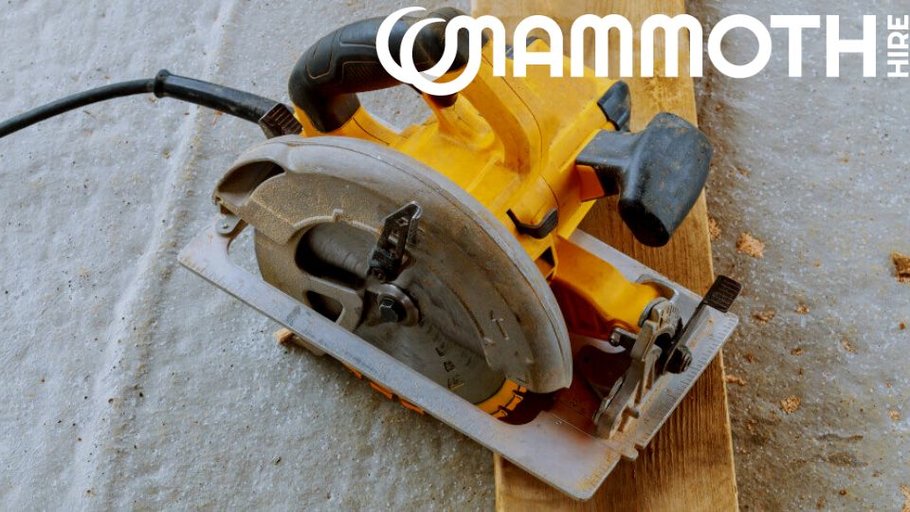How to Use a Circular Saw

If you're a first-time user of a circular saw, this great tool might seem intimidating. There are many different brands and sizes, and this amount of choice may leave you feeling swamped with decisions!
Despite this choice, we assure you that most circular saws come with the same basic set-up and design, so with a few basic handy tips, you'll be using this workbox essential in no time!
What is a circular saw used for?
We know that getting that perfect finish is the most important goal for the crafter with any project, large or small. A circular saw provides accurate, clean and perfect cuts through various materials to give you the finish your project deserves!
A circular saw, for the uninitiated, is a power saw fitted with a serrated or abrasive disc-shaped blade. A circular saw allows any craftsperson or DIY enthusiast to make precise cuts through anything from timber, plywood, and blockboard to modifying sheet metals.
Although the basic structure of circular saws remains largely uniform across different brands, what does change is whether the saw is cordless or electric. Alongside the size of the blade you use, being cordless or corded will be the most significant difference you encounter when selecting a circular saw.
Once you begin using this power tool effectively, it will transform your finished work from good to outstanding!
How to cut with a Circular saw
Before we begin some step-by-step tips, ensuring you wear the correct safety equipment is essential when using a circular saw successfully. We recommend wearing gloves, safety eyewear and a mask as, depending on the material being cut, dust particles can irritate the eyes, lungs and skin.
Get to know the tool - It's probably frustrating to begin with the most obvious step- but this tip is not to be skipped. Knowing your way around the circular saw and how to use it and hold it properly will ensure the neatest finish to your work. Take the time to familiarise yourself with the tool and the blade, ensuring you have the correct blade for the material you want to cut. For example, not all blades will cut concrete or certain sheet metals.
There are various circular saws, but the basic design for the majority of circular saws remains the same. When using the circular saw, you will grip the tool by using both its front and back handles and use the trigger at the back of the tool to control the movement of the circular blade.
Measuring and marking - The circular saw can't do all the hard work; measuring and marking out where you want to cut is crucial to the precision of your cut. A simple but accurate pencil mark or some masking tape, measured well, will help you guide the blade whilst the saw is on.
Securing your material - Make sure your workstation is free from obstructions and that the worktop itself will not be damaged or give way whilst you are cutting; this ensures your safety and that accurate cut you desire. It is best to secure your material on a saw table or between two sawhorses, adjusting according to the type and thickness of the material.
Adjusting cut depth and angle- The central lever on the main blade is used to control the desired cut depth. To allow the baseplate to move freely, pull the lever between the two handles. You can place the baseplate on the material and raise and lower it to adjust the depth you are cutting. You should always set the blade depth ¼ inch below the material you are cutting. Setting the saw blade to the right depth will reduce friction, allowing for a smoother cut.
Close to the baseplate, you will see a small button or notch with '0' on it. This tells you the position and angle of the blade. You can often use a slide attachment to keep your saw straight as you cut along.
Activate - Once this is in place, this is the time when you can plug in the saw. Doing this beforehand is dangerous, as the saw is not correctly set up. You can activate the saw mechanisms by pulling a trigger on the rear handle. Most models have additional safety triggers, which you can find in models manuals. Once you pull this trigger, the blade will begin to spin; wait until it gets to full speed to start your cutting.
Working it - Taking your time to learn about this power tool will give you the best result. When beginning, move the saw slowly along the material using both hands to cut down your marked lines carefully. A handy hint is to make sure the right side of the base plate always stays in line with the cut line that you have marked out.
Types of cuts
There are two types of straight cuts you will be able to do with a circular Saw. There is:
A crosscut - This type of cut is different as it goes against the grain of the wood. This can be used to trim or adjust something to a specific size or length.
A rip cut - As an opposite of a crosscut, the rip cut goes with the wood grain or material and gives a longer cut. There are often attachments to ensure accurate 'ripping', and clamping and measuring down to the board helps the precision of the cut too!
Taking care of circular sawblades
Safety is essential when using a power tool such as this. However, beyond learning how to handle such a tool properly, what is as important is taking care of the blade to ensure your safety and the tool's longevity. These are just a few simple tips to ensure both of these factors;
Using the right blade - There is a broad choice of circular saw blades. You must pick depending on; the size of the saw itself and the type of material you desire you cut. To Change a blade; Pull back the saw's upper blade guard to remove the old blade. Slip the new blade into the saw, making sure the teeth of the blade face the direction of rotation. Then adjust the tightness to ensure it's snug but not overtight, or it will be difficult to remove next time!
Cleaning and storing - After using the tool, you should always wipe the whole device and blade with a damp cloth, ensuring the power is off. Also, make sure everything is dry before you store it away. Dirt can affect how the circular saw performs, so it is essential to take care of the different blades.
Final tips
A circular saw can transform any DIY, home maintenance, or craft project. Although they may seem tricky and even dangerous at first, they are all designed with fantastic safety features and easy to use guides to help even the most apprehensive DIY beginners! Whether designing furniture or some cheeky home improvements, we are sure we have the proper circular saw for your project.



